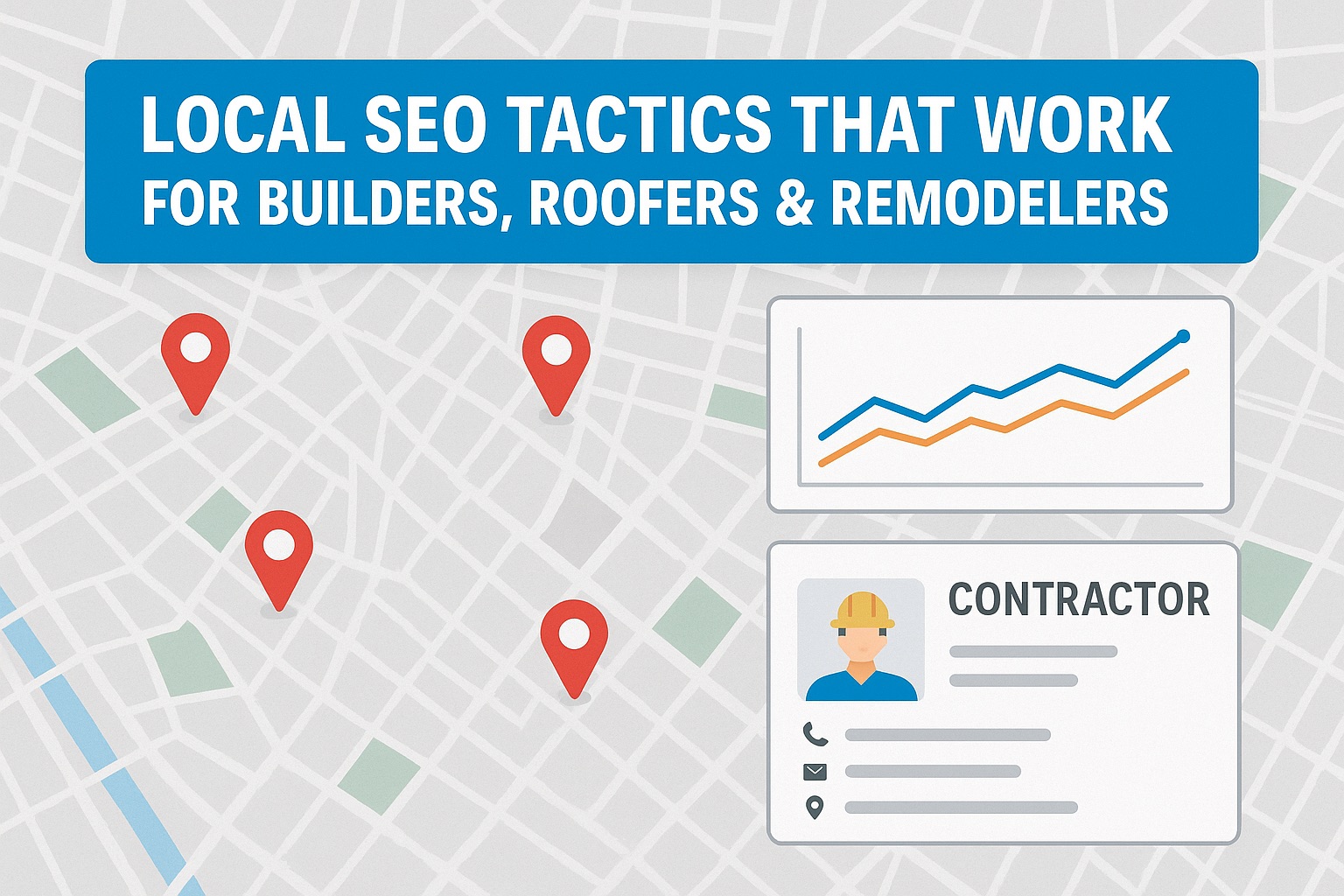Homeowners aren’t flipping through phone books anymore. Over 97% turn to Google first when searching for skilled tradespeople nearby. Yet 14% of construction professionals still lack even a basic online presence, leaving money on the table in an increasingly digital-first market.
This gap creates huge opportunities for builders, roofers, and remodelers ready to adapt. Traditional methods like word-of-mouth referrals still matter, but they’re no longer enough. Your future clients are searching right now – the question is whether they’ll find you or your competitors.
Mastering modern visibility tactics helps construction businesses stand out when homeowners need urgent repairs or renovations. It’s about more than just ranking higher. Effective strategies turn your website into a 24/7 lead generator, build trust through authentic reviews, and create lasting connections within your service area.
Key Takeaways
- 97% of homeowners start their search for tradespeople online
- Construction businesses without websites miss high-intent clients
- Digital visibility reduces reliance on costly traditional advertising
- Tailored strategies address seasonal demand and service area limits
- Clear implementation steps outperform theoretical concepts
This guide cuts through the noise with practical steps specifically designed for the construction industry. You’ll learn how to optimize your online presence, leverage automation for reviews, and convert searches into booked jobs – all while maintaining focus on your craft.
Table of Contents
Introduction to Local SEO for Contractors
Geographic targeting transforms how tradespeople connect with clients. Unlike broad digital strategies, this approach focuses on neighborhood-level visibility where urgent service requests happen. Let’s explore how specialized optimization creates lasting advantages.
How Location-Based Optimization Works
Search platforms prioritize three elements when suggesting providers: physical proximity, service relevance, and community reputation. A roofer 5 miles away consistently outranks competitors 20 miles distant – even with identical credentials. This creates predictable patterns contractors can leverage.
| Traditional SEO Factor | Local SEO Priority | Impact on Visibility |
|---|---|---|
| General keywords | “Near me” phrases | 47% higher click-through |
| Backlink quantity | Local directory listings | 33% ranking boost |
| Mobile compatibility | Google Business Profile | 3x more profile views |
Turning Searches Into Scheduled Jobs
Homeowners typing “emergency water damage repair” need solutions now. Optimized profiles and websites answer this urgency better than billboards or mailers. One study showed 68% of searchers contact businesses appearing in map results within 24 hours.
The strategy’s cost efficiency becomes clear when comparing lead sources. While social ads demand constant funding, a well-optimized presence keeps attracting clients years after implementation. It’s why 89% of successful trade businesses maintain updated local listings.
Optimizing Your Google Business Profile
Your digital storefront starts with a Google Business Profile – the first thing potential clients see when searching for services. This free tool acts as a 24/7 virtual receptionist, displaying critical details like operating hours, service areas, and customer ratings.
Take Control Through Verification
Unclaimed profiles often contain outdated information or incorrect categories. By verifying ownership, you ensure accurate details appear in search results. The process involves:
- Confirming business address via mail or email
- Selecting precise service categories like “Roofing Contractor”
- Adding license numbers for regulated trades
| Unclaimed Profile | Verified Profile | Visibility Impact |
|---|---|---|
| Basic info only | Full control over details | 2.7x more clicks |
| No review responses | Direct customer interaction | 41% trust boost |
| Generic map pin | Custom service area radius | 19% wider reach |
Build Trust Through Consistency
Name, address, and phone number (NAP) mismatches confuse both customers and search algorithms. A study found businesses with consistent NAP across platforms rank 37% higher in local searches. Pair this with genuine reviews to create compelling social proof.
Regularly updating photos of completed projects and posting seasonal offers keeps your profile active. Profiles with weekly updates receive 5x more inquiries than stagnant listings. “Clients want proof you’re operational and responsive,” notes a Simple Web Solutions specialist.
Website Optimization for Mobile and Fast Loading
Smartphones have become the primary tool for homeowners seeking immediate contractor services. With 60% of searches occurring on mobile devices, your digital presence must deliver seamless experiences across screens. Sites that load slowly or display poorly risk losing potential clients to competitors within seconds.
Mobile-First Design Principles
Prioritizing mobile compatibility isn’t optional—it’s essential. Responsive layouts automatically adjust content for different devices, ensuring buttons remain clickable and text stays readable. One study found 74% of users abandon sites that aren’t mobile-friendly—a critical concern for time-sensitive projects like storm damage repairs.
Key elements include simplified navigation menus and prominently placed contact options. Phone numbers should initiate calls with one tap, while forms must minimize typing through dropdown menus and auto-fill features. These adjustments reduce friction during urgent service requests.
Improving Website Speed and User Experience
Page load times directly influence engagement and conversions. Google penalizes slow sites, often pushing them below competitors in rankings. Tools like image compression and browser caching help pages load in under two seconds—the threshold where bounce rates spike.
| Speed Factor | Ideal Target | Conversion Impact |
|---|---|---|
| First Contentful Paint | 1.8 seconds | 24% more leads |
| Time to Interactive | 2.5 seconds | 38% lower exit rate |
Meanwhile, clear service descriptions and visible call-to-action buttons guide visitors toward scheduling consultations. Platforms like Simple Web Solutions combine technical optimizations with intuitive layouts, turning casual browsers into committed clients.
Effective On-Page SEO Techniques for local seo for contractors
The foundation of digital visibility lies in precise language alignment between homeowners’ searches and your website’s content. While technical elements matter, strategic word choice determines whether your services appear when prospects need them most.
Mapping Customer Language to Web Content
Effective research starts by analyzing how clients describe their needs. A roofer might target “storm damage repair” while remodelers focus on “bathroom renovation ideas.” Tools like Google’s Keyword Planner reveal search volumes for phrases like “emergency electrical services” versus generic terms.
Data shows 22% of trade websites lack H1 headers – critical markers search engines use to understand page topics. Pages under 200 words struggle to rank, while comprehensive guides answering common questions often dominate results.
Crafting Click-Worthy Titles and Descriptions
Title tags serve dual purposes: informing algorithms and enticing clicks. Compare these approaches:
| Generic Title | Optimized Alternative | Click Potential |
|---|---|---|
| Roofing Services | Emergency Roof Repair in Springfield | 24/7 Response | 63% higher |
| About Us | Trusted Home Remodelers Serving Dallas Since 2012 | 41% boost |
Meta descriptions should blend keywords with persuasive benefits. Instead of “We do kitchen remodels,” try “Transform Your Cooking Space: Custom Kitchen Designs Tailored to Your Lifestyle.” This approach addresses both technical requirements and human motivations.
Platforms like Simple Web Solutions help businesses implement these tactics through structured audits and content planning. Their methods focus on natural integration – ensuring optimization enhances rather than disrupts the user experience.
Leveraging Review Automation and Reputation Management
Customer opinions now shape purchasing decisions more than ever. With 90% of homeowners checking reviews before hiring, your online reputation directly impacts lead generation. Platforms like Google prioritize businesses with consistent positive feedback, making review management a critical marketing tool.
Collecting 5-Star Reviews with Ease
Timing determines review success. Automated tools send requests immediately after project completion when satisfaction peaks. This approach yields 3x more responses than manual methods. For example, PJ Fitzpatrick built trust through 8,000+ reviews using systematic outreach.
| Manual Approach | Automated System | Outcome |
|---|---|---|
| Random timing | Post-service requests | 87% completion rate |
| Single platform focus | Multi-channel distribution | 41% wider reach |
| Delayed responses | Real-time notifications | 2-hour resolution time |
Handling Negative Feedback Privately
Criticism becomes constructive when addressed discreetly. Private resolution channels let businesses fix issues before reviews go public. “Clients appreciate quick solutions,” notes a Simple Web Solutions specialist. This protects reputation while demonstrating accountability.
Branded widgets showcase verified testimonials across websites and social media. These tools convert casual visitors into confident buyers by highlighting real success stories. Combined with professional response strategies, they create lasting trust that drives repeat business.
Implementing Schema Markup and Structured Data
Invisible website code holds surprising power to boost visibility. Structured data acts like a translator, helping search engines understand your offerings and location. This technical layer clarifies your expertise for algorithms, making your services stand out in crowded search results.
Speaking Google’s Language
The LocalBusiness schema acts as a digital ID card. It specifies your address, phone number, and service areas. Websites using this markup see 29% better accuracy in local queries. For example, a roofer’s profile might highlight emergency storm repairs within specific zip codes.
ProfessionalService schemas take this further. They showcase certifications, project types, and specialty skills. This helps match your business with precise searches like “historic home restoration experts” instead of generic terms. Platforms like Simple Web Solutions embed these codes seamlessly during website builds.
Rich snippets transform basic listings into attention-grabbing results. Verified reviews appear as star ratings, while service hours display without clicking through. One study showed listings with structured data get 35% more clicks than standard entries.
| Without Schema | With Schema | Visibility Boost |
|---|---|---|
| Generic description | Highlighted specialties | 41% CTR increase |
| Basic contact info | Interactive service maps | 2.3x engagement |
While implementation requires technical skill, the long-term benefits outweigh initial efforts. Structured data future-proofs your online presence as search features evolve. As one specialist notes, “It’s like giving GPS coordinates to clients actively searching for your expertise.”
Building Quality Backlinks and Local Citations
Trusted recommendations drive decisions in service industries. Search engines value these digital endorsements through backlinks and accurate citations. Establishing authority requires strategic partnerships and precise listings across key platforms.
Strategic Directory Listings
Industry-specific platforms like HomeAdvisor and Angi carry weight with search algorithms. Complete profiles with matching address details boost visibility by 29%. Simple Web Solutions streamlines submissions to 50+ directories while ensuring NAP consistency.
Partnership-Driven Link Building
Collaborating with material suppliers or trade schools creates natural linking opportunities. Guest posts on community blogs or event sponsorships generate referral traffic. These connections signal relevance to search engines while expanding your business network.
Effective strategies focus on quality over quantity. One authoritative website link often outperforms dozens of low-value connections. By combining verified citations with genuine partnerships, tradespeople build lasting credibility that converts searchers into clients.
FAQ
How does a Google Business Profile help contractors get more clients?
A verified Google Business Profile boosts visibility in local search results and Google Maps. Contractors who include accurate contact details, photos, and respond to reviews often rank higher for terms like “roofers near me” or “home remodelers.”
What’s the fastest way to improve website loading speed?
Compress images, use caching plugins, and minimize code. Tools like Google PageSpeed Insights identify bottlenecks. Faster sites rank better and keep visitors engaged—critical for contractors competing in crowded markets.
Should remodelers focus on mobile-friendly website design?
Yes. Over 60% of local searches happen on mobile devices. Responsive designs adapt to screens, improve user experience, and align with Google’s mobile-first indexing—a key factor in local SEO rankings.
How do backlinks from local directories impact search rankings?
Quality citations from sites like Yelp, HomeAdvisor, or BBB signal credibility to search engines. Consistent Name/Address/Phone (NAP) details across directories also reduce confusion and strengthen local relevance for contractors.
Can schema markup really make a difference for small contracting businesses?
Absolutely. Adding LocalBusiness schema to your website helps search engines display your services, hours, and reviews directly in results. This structured data can improve click-through rates by up to 30% for service-area businesses.
What’s the best strategy to handle negative online reviews?
Respond promptly and professionally, then take the conversation offline. Offer to resolve issues privately. A thoughtful approach shows potential clients you value feedback—and can even turn critics into advocates.
How often should contractors update their service pages for SEO?
Refresh content quarterly. Add new project photos, update service areas (e.g., “kitchen remodeling in Austin”), and incorporate trending keywords. Fresh content signals relevance to search engines and keeps visitors engaged.





0 Comments